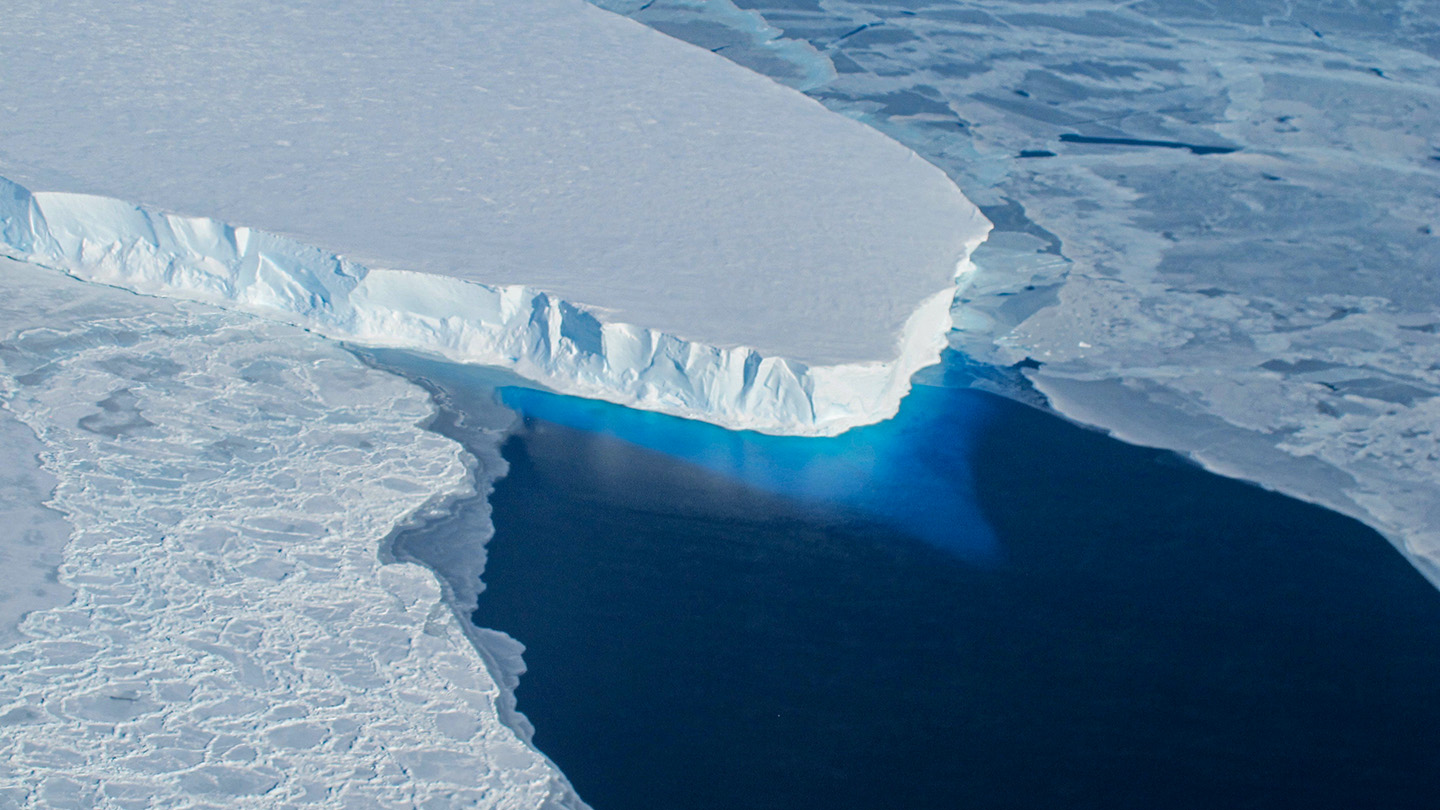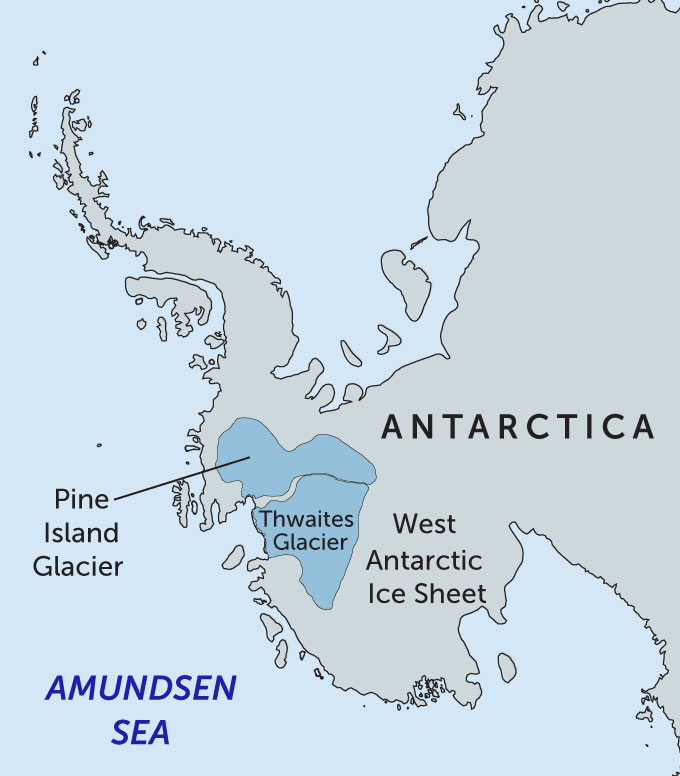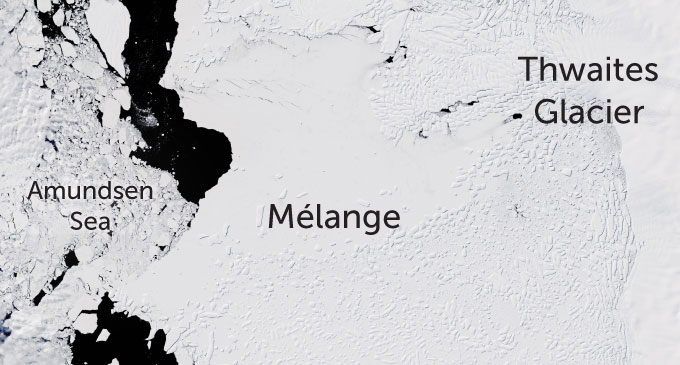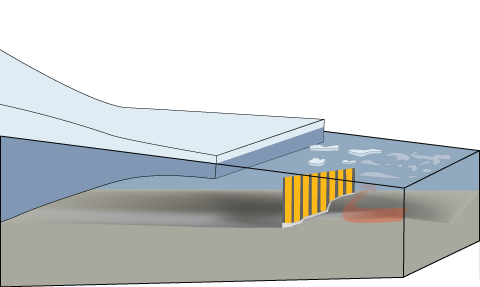Icebergs bigger than aircraft carriers crowd the area where Thwaites Glacier pours into the ocean. Those bergs calve from this and other glaciers that ooze off the edges of the West Antarctic Ice Sheet — a dome of ice as large as Mexico.
This region at the bottom of the world could become the site of some of the biggest engineering projects the world has ever seen. Researchers are sketching ideas on how to protect West Antarctica’s ice from global warming. The proposed projects would block warm ocean currents or alter the flow of vast glaciers.
These projects could be “just enormous,” says Christian Rodehacke. He’s a glaciologist in Bremerhaven, Germany. He works at the Alfred Wegener Institute for Polar and Marine Research.
Ultimately, each project hopes to slow how rapidly seas will rise across the globe.
Yet the mere idea of engineering glaciers has provoked heated debate, even among scientists who know and respect one another. Can it be done, some ask? Should it be done? And who would pay for such enormous projects?
Thwaites is the widest glacier in the world. It’s also the most vulnerable in West Antarctica. It holds 480,000 cubic kilometers (115,000 cubic miles) of ice. Right now, it’s losing about 80 cubic kilometers (19 cubic miles) per year. This is six times faster than in the 1990s. And its ice loss continues to speed up as the world warms.
If Thwaites were to collapse, it would release enough ice to trigger disastrous sea-level rise across the globe. And even if humans stop releasing climate-warming gases in the near future, this still might not prevent a collapse.
So a few scientists are investigating whether glacial engineering could prevent or delay sea-level rise. Slawek Tulaczyk is one of the people pushing for this to happen. He’s a glaciologist at the University of California, Santa Cruz. “Maybe the conclusion will be that we should not do it, or that we won’t be able to do it,” he says. But he believes that scientists should at least look into the possibility.
Tulaczyk and others caution that glacial engineering would never be a silver bullet. Even if it saves Thwaites or other glaciers in Antarctica, it may not preserve glaciers in the Arctic, where temperatures are warmer.

How to slow runaway glaciers
People have thought about engineering ice for lots of purposes. In the 1980s, for instance, a few scientists and engineers talked about towing icebergs to provide fresh drinking water.
Douglas MacAyeal was a graduate student in glaciology at Princeton in 1983 when he learned about that idea. It inspired him to think about other ambitious ways that humans could engineer glaciers to solve big problems. He wrote a brief abstract to present at a science meeting. It proposed pumping large amounts of seawater onto the floating fronts of glaciers. By freezing there, it would thicken the ice, causing it to rest more heavily on submerged mountains below. That stronger anchoring might slow the glacier’s rate of flow.

In the end, the young scientist never pursued the idea. He was looking to get a job and didn’t think this “silly idea” would help him land one. He ended up at the University of Chicago, rejoining the conversation on glacial engineering only in 2023 — as he was retiring.
Tulaczyk, too, has long thought about engineering ice flows. While working on his Ph.D. in the 1990s, he studied a coastal site in West Antarctica, roughly 1,200 kilometers (745 miles) east of Thwaites.
Six massive glaciers ooze off that coastline. Most of them slide 300 to 700 meters (980 to 2,300 feet) forward each year. But scientists found that one, the Kamb Ice Stream, flowed only two percent that fast.
Kamb had once moved as quickly as the others. Then, some 150 years ago, it ground to a near-halt.
A thin layer of liquid water lies beneath most glaciers. This lubrication lets them glide over rough beds of gravel. That water comes from a slow melting of ice on the glacier’s bottom. It melts due to the heat of friction and heat that seeps out of the ground from deep in the Earth.
Tulaczyk and some others thought a loss of this water layer might have slowed Kamb. Like a river jumping its banks, that water seemed to have migrated elsewhere.
By the late 2000s, Tulaczyk was wondering if it might be possible to slow other glaciers by mimicking what happened at Kamb. He imagined drilling holes through a glacier and pumping out the water below. This might eventually freeze the glacier to its bed, as Kamb had — stalling the ice flow for decades or centuries.
Tulaczyk presented the idea to a small group of climate scientists in 2008. Alas, he never got funding for a workshop at which scientists might discuss this further.
Do you have a science question? We can help!
Submit your question here, and we might answer it an upcoming issue of Science News Explores
The idea gets a comeback
Two events helped revive his idea a decade later.
Around 2018, Tulaczyk received an email from the sci-fi novelist Kim Stanley Robinson. The author had been one of the few nonscientists present at Tulaczyk’s 2008 talk. Robinson ended up including the idea in his 2020 novel about people who successfully responded to climate change and sea-level rise. (In it, a glaciologist named Slawek proposes Tulaczyk’s strategy for slowing glaciers.)
Then, in 2023, Tulaczyk received an email from Alex Luebke. This tech entrepreneur had founded companies to develop satellites and run advanced projects at Google X. Luebke had read Robinson’s book. He, too, loved the idea of engineering glaciers. So he asked Tulaczyk how he might help push for this.
A few months later, Luebke and several scientists held a workshop for 50 people to discuss how they might fund and test glacial engineering.
The very idea provoked strong reactions among scientists in the field. One, Martin Truffer, is a glaciologist at the University of Alaska Fairbanks. He’s known Tulaczyk for years. He’s worked with him on projects and respects him. But he still found the idea outrageous.
On the first morning of the workshop, people were asked who was against glacial engineering. Roughly half the attendees raised their hands. When asked who was undecided, the other half — including Tulaczyk — raised their hands.
Yet to Tulaczyk, this was a good start. The goal, he says, was simply for this “to become a legitimate research area.”
Now Tulaczyk, Truffer and Ken Mankoff, a glaciologist at NASA’s Goddard Institute for Space Studies in New York City, are among scientists at last making plans to test the idea. Their first mission: Raise money to fund these studies.
If they get it, they might start initial tests in the next several years at a small glacier in Alaska. The researchers would use a jet of hot water to melt a bowling ball–sized hole through the ice. Then they’d pump water out from underneath it for the next month or two.
Truffer still sees glacial engineering as impractical and unrealistic. But he notes that research into it could answer key questions about how water controls a glacier’s flow. Glacial engineering might never happen. But even so, this research could help in predicting how quickly glaciers will lose their ice as temperatures rise.
What it takes to brake a glacier
Such tests would also hint at how many holes might be needed to slow down a monster glacier like Thwaites.
Roughly 1 to 3 cubic kilometers (0.2 to 0.7 cubic miles) of water flow out from beneath Thwaites each year. The idea would be to drill holes where the glacier slides over rough bedrock (rather than soft mud). Removing just 1 to 3 percent of that water might vastly increase the drag on the ice, Tulaczyk speculates.
He thinks it might take as few as 10 holes, each with a pump pulling out 100 liters (26 gallons) of water per second. Existing well pumps can do that. But they might end up needing to pump out 10 times that much water.
Brent Minchew at the Massachusetts Institute of Technology, in Cambridge, has proposed something similar. This glaciologist would pull heat from the glacial bed. The idea: Make the subglacial water freeze.
He’d use a thermosiphon. Such devices create a convection current. Warm gas bubbles in it rise within a sealed pipe of condensed carbon dioxide. This leads the colder liquid to sink. It takes the gas bubbles’ place at the bottom. Heat from the bubbles would then escape through the top of the pipe and into the environment.
Thermosiphons help stabilize the Trans-Alaska Pipeline by keeping permafrost from thawing and sagging beneath the pipe. At Thwaites, such devices would drain the heat slowly, over years. Eventually, the glacier might freeze onto its bed. For “this particular race,” says Minchew, “slow and steady wins.”
What about blocking warm ocean currents?
The Southern Ocean surrounds Antarctica. Nowhere else can westerly winds circle the globe without encountering land. These winds pile water into waves that can reach the height of a four-story building. They also drive the most powerful ocean current on Earth.
Climate change has been strengthening those winds. And that has caused this circumpolar ocean current to intensify and shift toward the coast of Antarctica.
This current riffles against the edge of Antarctica’s continental shelf, several hundred kilometers off the coast. Its powerful turbulence lifts deep, warm water onto the edge of the shelf.
Owing to its high salt content, this deep water is a bit denser than the cooler water on the continental shelf. That slight difference guides the warm, dense water into a deep seafloor groove called the Pine Island Trough. This trough dips several hundred meters below the rest of the shelf. It offers an easy path for dense, salty water to flow inland and access the fronts of those glaciers.
This water is just 2 to 3 degrees Celsius above freezing. That warmth might not sound like much. But 2,800 cubic kilometers (670 cubic miles) of this water flows inland each year. That’s nearly enough water to fill Lake Ontario twice. The heat it delivers to the front of Thwaites is similar to the output of 450 nuclear power plants.
Michael Wolovick wondered if it might be possible to block that warm water by building a barrier across the seafloor in front of Thwaites.
Wolovick now works for the Alfred Wegener Institute for Polar and Marine Research in Germany. But eight years ago, while doing his glaciology training, he presented his idea at a conference.
John Moore loved the idea and introduced himself to Wolovick at that meeting. A glaciologist, Moore works at the University of Lapland in Finland. The following year, he, Wolovick and several other scientists wrote a controversial essay calling for research into glacial engineering.
In a second paper, they proposed building a dike up to 120 kilometers (75 miles) long in front of Thwaites. It would block incoming warm currents by cutting off several branches of the Pine Island Trough.
When Bowie Keefer learned of this proposal, he contacted Wolovick and Moore. Keefer is an engineering physicist from the west coast of Canada. He worried the dike would be demolished by drifting icebergs.

Those bergs are up to 400 meters (1,300 feet) thick. Their undersides frequently scrape and gash the seafloor.
You’d have to design the barrier “so icebergs can go over it without destroying it,” Keefer says. He instead imagined something like the flexible streamers of kelp that his kayak slides through in waters near his home.
In March 2023, Keefer, Wolovick and Moore published two papers in PNAS Nexus. They proposed thin, buoyant sea curtains anchored to the seafloor. While blocking dense, salty, bottom-hugging currents, these curtains would bend easily as icebergs drifted over them.
Keefer imagines a couple thousand overlapping panels, each about as wide as a football field. If damaged, any of them could be replaced. The flexible barriers would have to reach as much as 250 to 450 meters (820 to 1,480 feet) up from the seafloor. The largest might be as tall as the Empire State Building!

They estimate this would cost $40 billion to $80 billion. Maintenance might cost as much $2 billion per year more. This sounds expensive. But it’s far less than what it would cost to build and care for dikes to protect coastlines around the globe from rising seas. That’s estimated to run $20 billion to $55 billion per year if global temperatures rise 3 degrees Celsius (5.4 degrees Fahrenheit) above preindustrial levels. The warming climate is already halfway there.
Scientists are debating whether a seafloor barrier might just redirect warm currents — and melting — to other glaciers farther west on the Antarctic coast. And researchers are still considering what materials might work to make these curtains.
Smooth plastic would work — but would also release microplastics into some of the world’s most pristine waters. That’s not ideal.
As one potential alternative, Ole Wroldsen envisions a net made of plant fibers. He’s a marine civil engineer with a consulting company in Fornebu, Norway. Over time, sponges, corals, mollusks and other marine animals would likely adhere to the net. This should increase its ability to block currents. The living structure would be “acting with nature rather than against nature,” he says.
The first curtain-related field tests could start in a year or two — once researchers find money for it. A series of small curtains, each 10 meters (33 feet) high, could be tested in a Norwegian fjord to see how long they last. Larger versions might be installed later, temporarily, to test their effect on ocean currents. Moore thinks it might happen in a glacial fjord somewhere in the Arctic.
And the downside?
Many Antarctic scientists are still opposed to glacial engineering. They believe it could have unintended side effects.
Sharon Stammerjohn is a sea-ice scientist at the University of Colorado Boulder. She worries that sea curtains might cause turbulence that mixes deep, warm water into the upper layers of the coastal ocean. This displaced warmth could reduce sea ice in affected areas.
There’ll be “winners and losers” from such a plan, Stammerjohn says. For instance, the curtains could cause ocean plankton levels to rise or fall in some areas. That could help — or harm — not only the krill that eat these plankton but also the penguins and whales that eat the krill.
Scientists also worry that a huge effort to engineer glaciers could distract people from finding ways to cut greenhouse gas emissions. That, after all, is the only true solution to climate change.
Trying to build glacier engineering projects and keep them working will also prove very challenging.
Thwaites Glacier sits midway along some 7,000 kilometers (4,400 miles) of coastline without a single permanent outpost. No human even stood on this glacier’s heavily crevassed ice shelf until 2019. And icebreakers sent there to conduct research have only a 50-50 chance of making it in any given year. Some scientists doubt whether humans could even make such a huge project work in this remote part of the world.
Tulaczyk is now nearing retirement. He accepts these concerns. But he believes that global warming and sea-level rise pose such a serious threat that even extreme ideas, like glacial engineering, are worth at least looking into.
He’s pleased that younger scientists like Wolovick and Mankoff are following through on his initial idea. What they’re doing is “amazingly courageous,” he says — especially in the face of skepticism and resistance from many of their peers.

